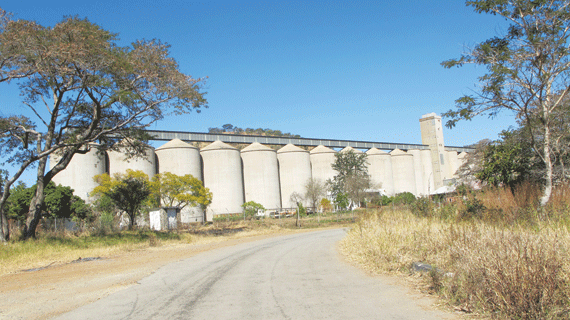


SILOS at the country’s leading grain trade institution, the Grain Marketing Board (GMB), which also bears the national burden of building strategic grain reserves to feed the country in crisis periods, are crumbling due to years of neglect, the Financial Gazette can exclusively report. The GMB has over 80 depots, 12 of which are equipped with silos for grain storage, spread throughout the country.
The GMB has over 80 depots, 12 of which are equipped with silos for grain storage, spread throughout the country.
But these are collapsing, according to investigations by this newspaper.
If the silos, which include Lions Den, near Chinhoyi, the world’s third largest such facility with a 104 000 metric tonne holding capacity, crumble due to massive seepage and peeling of walls, the country would find itself in a very precarious position in terms of grain storage.
The deplorable state of the silos has not escaped the attention of the government’s chief auditor, Mildred Chiri.
The silos are designed to hold up to 500 000 metric tonnes of strategic grain reserves.
According to the auditor general’s report, the GMB’s silos across the country require over US$50 million for repairs to avert further deterioration.
Most of the silos are already unfit to store maize for human consumption as large volumes of water have penetrated the structures over the past six years. And at about 58 years old each, the silos have not been refurbished for many years.
Official documents exclusively obtained by the Financial Gazette pointed to a rapidly unfolding crisis, which could spiral out of control unless the GMB, a State monopoly for many decades, accesses funding to repair the grain silos that have been swamped by water.
The water has weakened foundations and walls, forcing structures to crack, and turning the facilities into grain roasting machines that have destroyed millions of dollars worth of grain while millions of people starve countrywide.
Thousands more metric tonnes of grain have been turned into cake and condemned by authorities as unfit, sometimes even to feed livestock.
In fact, the first indications of a potential crisis emerged between 2010 and 2012 when 61 400 metric tonnes of maize, enough to feed nine million people for one month, were affected by a condition known as bin burn.
“My inquiry with the Consumer Council of Zimbabwe revealed that these quantities could have fed 1 534 900 households of six people each for a period of one month,” said auditor general, Chiri, in her report of the facilities covering the period April 1, 2009 to March 31, 2012.
“Grain Marketing Board is supposed to maintain grain storage facilities in a proper condition suitable to store grain for at least three years without the grain losing its quality or grade,” Chiri added.
Her audit report revealed that many of the silos, which have been accumulating huge volumes of water since 2009 when the first cases were reported, could still be standing because they are empty.
At about nine percent full in 2009/2010, GMB’s grain silos were almost empty.
The silos held only 44 percent of their capacity in 2010, while in 2011/2012, the facilities held about 60 percent of their capacity.
“From external physical appearance of the silos, one is convinced that GMB has state-of-the-art storage facilities when in actual fact the facilities are no longer suitable to store maize as expected as most of them developed multiple cracks which allow water to seep through causing bin burn and cracking,” Chiri warned.
“All the seven silo depots visited namely Chiweshe, Mrewa, Aspindale, Concession, Lions Den, Mukwichi and Karoi have not been refurbished although they were long overdue (for refurbishment).”
“Some of them were over 58 years old and had not been refurbished and had developed multiple cracks due to weather conditions. Peeling off of silo walls was also noted. The cracks and peeling offs were allowing water to seep through causing caking and bin burn of maize in the silos. Lions Den, the third largest depot in the world after Austria and Egypt in terms of carrying capacity, had only five out of 29 silos that were suitable for storage of grain. With the state of dilapidation of the bins, the depot can only hold up to 25 000 tonnes (five silo bins),” the report revealed.
“All the 14 bins at Karoi had multiple cracks, with surging walls allowing water to seep through,” said the auditor-general.
“There was no one bin that could be relied upon. This means its holding capacity of 70 000 metric tonnes cannot be utilised.”
All three silos at Mukwichi were non functional in 2009, the report said.
“Due to the poor state of the silos, the rate of bin transfer for the purpose of aeration at some of the silo depots visited such as Karoi, Aspindale, Lions Den and Concession had increased than expected in an effort to preserve the quality of the maize. Bins transfers present the GMB with other problems, such as broken chips of maize increase thereby resulting in loss of maize.”
Poorly maintained silos can be very dangerous, as demonstrated by the death of an employee of a Tyson feed mill in Nashville in the United States after a grain silo at the facility suddenly ruptured and blocked roads.
In December 2013, another worker went missing, presumed dead, after a grain silo collapsed and spilled 50 tonnes of corn at a feed mill in Washington State, according to media reports.
In November 2014, a corn silo fell and spilled a huge amount of the crop in Calhoun County, near Morgan in the US, while in June 2014 Wilcox Family Farms in America was fined US$67 200 for not properly maintaining a silo that collapsed in December 2013 and buried a worker under 500 tonnes of grain, killing him.
Most of these cases were farm silo collapses, caused by negligence under bad weather conditions like water seepage.
“In Zimbabwe, where the bulk of silos are State controlled, if catastrophic incidences like these happen, they will not only be embarrassing, but costly to repair,” said Charles Dema of the civil engineering firm, Southern Civil works in South Africa.
“Zimbabwean silos are not immune to collapse,” says civil engineering consultant, Gregory Miles, warning of devastating consequences for poor maintenance.
“It (collapse) may not happen today, or tomorrow,” adds Miles.
“But as long as the structural defects taking place in these silos are not attended to, we should surely know that we are sitting on a serious time bomb. You can have massive amounts of water percolating through these big bins for half a decade and still sit and assume everything is normal,” he notes.
In 2012, government came close to finalising a US$51 million transaction with Export-Import Bank of China (China Eximbank) but failed to raise the US$7,5 million deposit that the financial institution required to release cash for the repair of silos.
The auditor general said while the GMB raised revenue from renting out excess storage facilities, the money was insufficient to refurbish the silos and meet other costs.
“The financial statement figures give total storage fees of US$2 337 235 over the three year period. These revenues are inadequate to meet fumigation, handling of the third party stocks, repairs and maintenance budget for the 84 depots. The annual maintenance schedule for the silos is in place. However, it has not been adhered to because of inadequate support from Treasury. As at 2010, silos had gone for more than 15 years without undergoing major refurbishment. When the current board and management took over, a situational analysis was conducted and a US$51 million Strategic Grain Reserve…facility was identified in 2010. The facility was presented by GMB to the Ministry of Finance, who… (wrote) application letters to Export-Import Bank of China (China Eximbank) (in May) 2012. GMB suggested that some of the funds earmarked for grain procurement can be viremented since US$7,5 million was required as deposit to kick-start the project. This would have reduced grain losses,” it said.
newsdesk@fingaz.co.zw